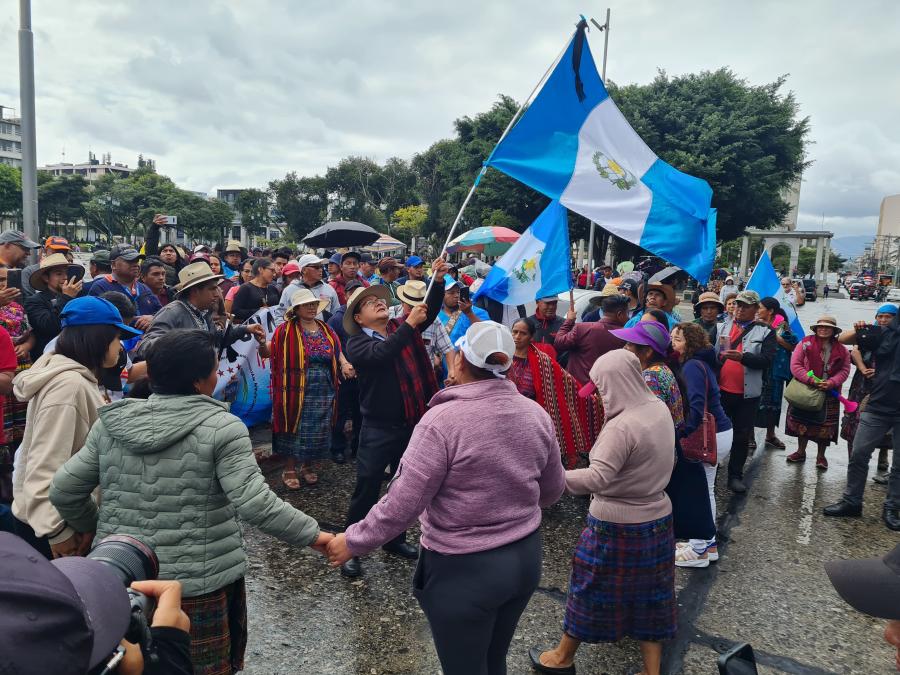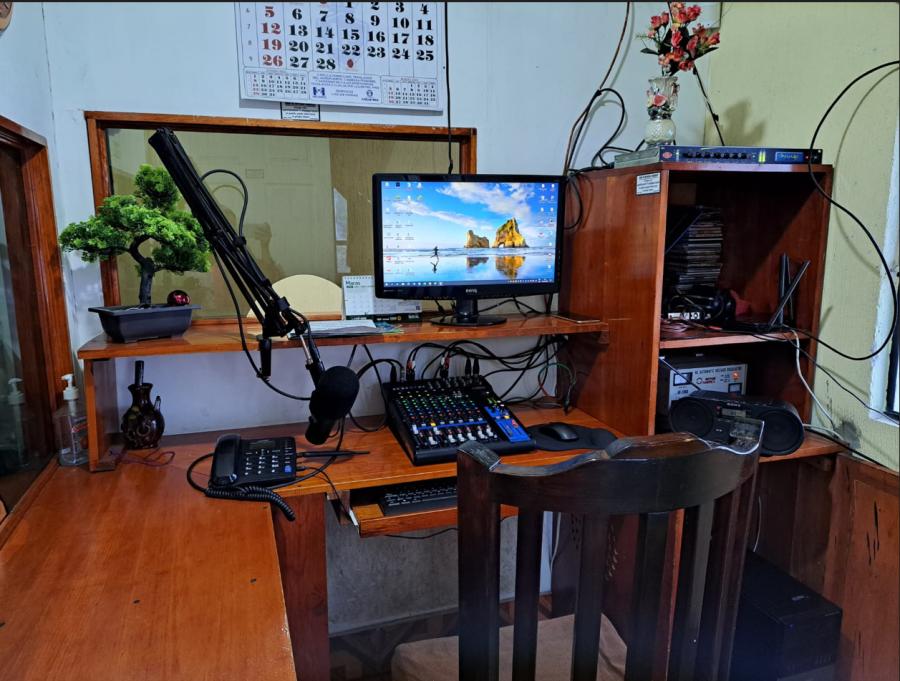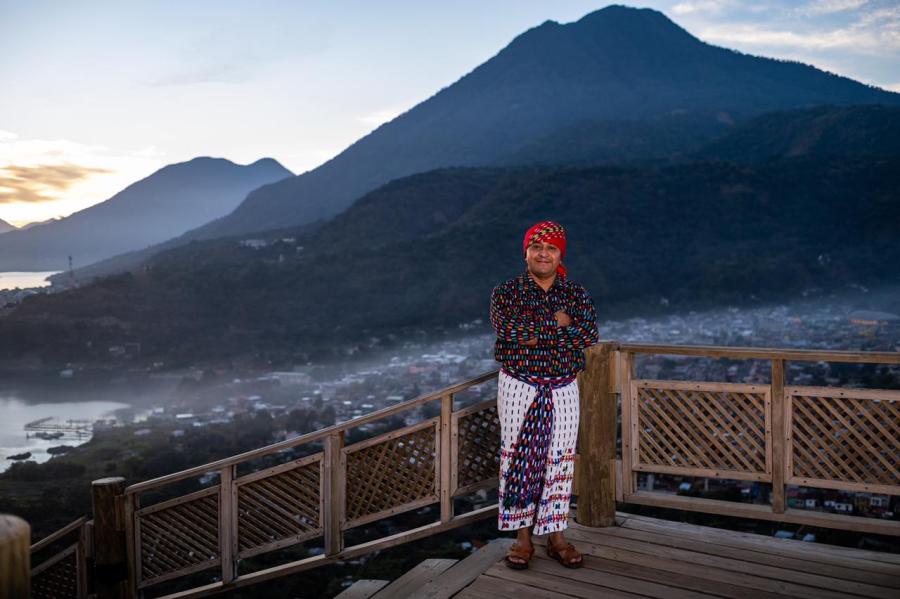When Jorge found me, I was having coffee with a friend in the lakeside town of Panajachel, Guatemala. Jorge was panting, having peddled a fast mile on his bike from the nearby village of San Jorge de la Laguna or `Saint George by the Lake.' "Hurry, they're going to hurt people," he pleaded. Four days into a tense land dispute and occupation, the military had finally arrived. There are ten Mayan villages around Guatemala's Lake Atitlan, a clear blue basin ringed by mountains including twin giant volcanoes and one lava-induced dwarf. In several villages, people's first language is Tzhutuhil. In San Jorge and the others it is Cachiquel. The women, especially, from both groups still wear tipica clothing. The general designs and colors are specific to each group, while the patterns and images within them are unique to each village.
I collected my foreign press credential and cassette recorder, while my friend, Michael, a photographer, dusted off his 35mm camera-I didn't want to cover the situation alone. We drove quickly to San Jorge. Descending a winding dirt road, we came upon two mismatched sides preparing to clash. About 50 armed military police confronted about an equal number of unarmed San Jorge villagers comprised of women, children, and men. Each side was arranged in three lines. The first rows of each were faced off like two touch football teams in a scrimmage. The first line of police wore solid dark blue uniforms and white helmets and wielded black truncheons. The first line of villagers, all women, wore dark red and black smocks known as guipils, embroidered with violet, pink and red flowers around the neck. The guipils were tucked into long black skirts with silver glitter and matching red trim.
Behind the women were a group of children. Even the tiniest girls also wore matching guipils and skirts. Behind the children were a group of men, most of them old and also wearing matching shirts and pants. (By then the younger men had abandoned the scene so as not to be perceived as provoking violence.) The old men were gathered around a flat green plank bier with sanded round handles. On top of it sat a motionless figure, a plaster statue of San Jorge. After the Conquest, San Jorge villagers had merged their own spiritual deity with that of Saint George the Dragon Slayer, one of many Christian deities forced upon the Maya people. San Jorge's ancestors accepted this icon and today, he is considered their modern-day spiritual guide. This plaster figure held a lance that looked and felt like it was a solid piece of silver. Elders from the village told me that the original conquistadors had brought the lance from Spain.
Behind the first row of helmeted police with truncheons stood another row of less men, more spread out. Each held either a tear gas grenade launcher or an Israeli galil automatic rifle. Behind them was another row of police, each holding a leash to a dog.
As we entered the scene, the Sergeant-in-command gave an order. The first line of police raised their truncheons, dogs barked, and soldiers wrapped index fingers around rifle triggers. The women held their line and sealed it by shuffling themselves closer together. Only a few of the children behind them began to cry. The elder men behind them reached down and raised San Jorge by his bier. The Sergeant turned to look at us, the only witnesses to the confrontation that was about to occur. Michael and I approached calmly and extended our hands. I gave the Sergeant my press credential and told him that my friend was a photographer working for me. He looked the credential over before giving it back. Then he ordered his men at ease. Everyone, including the dogs, found a spot in the shade. Two hours later, after it became apparent to the Sergeant that we weren't leaving, he ordered his men to withdraw.
Several days later the military returned and attacked at dawn. First they threw rocks, and then fired tear gas and moved in with truncheons. Dozens of people, including woman, children, and young teenage boys, were injured, many with gaping head wounds. Sixty-seven villagers, all adult men, were arrested. Soldiers tied each prisoner's hands behind his back and then tied them together in groups of six or seven. One young soldier carrying a galil rifle taunted one of the prisoners. He accused him of being a leftist guerrilla, claiming to recognize him from a firefight in the mountains. The prisoners were loaded onto army boats on Lake Atitlan and then ferried a short distance to Panajachel-a partly successful attempt to avoid waiting television cameras, which by mid-day, had gathered in San Jorge's square. In Panajachel, the prisoners were loaded onto old yellow school buses and taken to the municipal prison in nearby Solola.
This confrontation took place in 1992-the quincentenary year of Columbus' arrival. Two weeks later, all 67 prisoners were released. They were lucky, as they could have `disappeared.' Human rights groups accuse the military in Guatemala of forcibly `disappearing' up to 40,000 victims, and killing as many as 100,000 more in the course of its 30-year counterinsurgency against leftist guerrillas. In this case, however, hundreds of witnesses including dozens of foreigners saw the military detain San Jorge's men. It was reported by the local press. I wrote a story about it for the Christian Science Monitor. Rather than attract more attention, the military eventually freed them all.
Since then, the villagers of San Jorge have continued to hold their ground. Theirs' is a struggle over land, but not for growing food. The disputed area is approximately 200 acres of gently rising slopes between the shoreline of Lake Atitlan and the foothills holding the mountainside village of San Jorge. The area is too sandy to be fertile. Instead, this conflict pitches property rights and venture capital against the survival of this village. Two wealthy brothers from Guatemalan City, Luis and Carlos Saravia Camacho, are trying to build a hotel luxury resort between the village and the lake; the community is resolved to resist them.
San Jorge is no idyllic place clinging to its past. Members of every almost every one of its families work in some form of wage labor. Most families are also dependent on Lake Atitlan's tourist trade. But tourism around the lake has attracted more backpackers than tour buses so far. At present, there are only several large hotels and dozens of smaller hostels, mostly in nearby Panajachel. San Jorge, by comparison, is undeveloped.
The Camacho brothers want that to change and they hold legal title to the shoreline property between the lake and the village. But the community of San Jorge say they have "a historic right" to the same land, which they communally share, because their ancestors founded the village before the Conquest. The Camacho brothers bought the shoreline property in 1975 from Domingo Fuentes, a man who neither lived nor worked on the land. His parents acquired title to the land in the late 1800s-during the coffee boom that swept much of the Central American isthmus. During this period, Creole governments forcibly broke up land collectively held by indigenous communities and issued new titles to recent European immigrants. The changes created landowning oligarchies among the immigrants while greatly reducing the indigenous population's farmland.
If the Camacho brothers succeed in building their resort, they boast that it will be one of the largest in Central America. Any such endeavor would forever change San Jorge as well as other communities on the lake. Indeed tourism, in different ways, works in favor of both sides in this dispute. The idea that a five-star resort could attract upscale clients is the foreseen demand driving the Camacho brothers' plan. The proximity of San Jorge to Panajachel-which has the largest foreign presence of any highland Guatemalan village-is what deters the military from using force to control the villagers.
Another option would be to offer the community `carrots.' In 1992, the Camacho brothers offered to expand a school, improve electrical lines, and install sewers if the villagers would relinquish their claim to the land. The community said no. Since then, the situation has evolved into stalemate. By 1995, the villagers had built a flat board structure in the middle of the road which serves as the headquarters of San Jorge's volunteer fire brigade and first aid clinic. This ramshackle structure also doubles as a classroom for literacy training and a multi-purpose community center. It blocks all access to the terrain between San Jorge and the lake. So far no one has tried to remove it.
Can this village survive? The Camacho brothers are in no hurry to break ground. The combination of bad press over human rights abuses along with rising common crime has kept a lid on tourism in Guatemala. Recent attacks like the January 1998 rape of five students from St. Mary's College in Maryland will continue to keep all but the most unconventional tourists away. Someday, however, the memories of this and other attacks will fade and the Camacho brothers will again try to develop their planned resort. The community again will resist them.
The physical wounds from their first battle have healed. In fact the only permanent loss was to San Jorge himself. In the confusion of the dawn attack, the military stole his silver lance. Does this worry the community? "No," one elders says; "San Jorge draws his strength from the people, and the people draw their strength from him."
Article copyright Cultural Survival, Inc.



